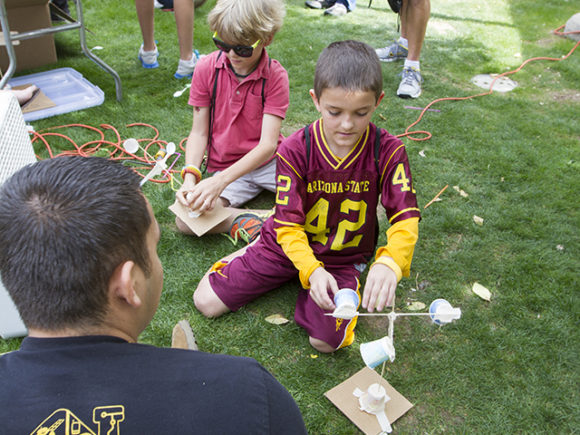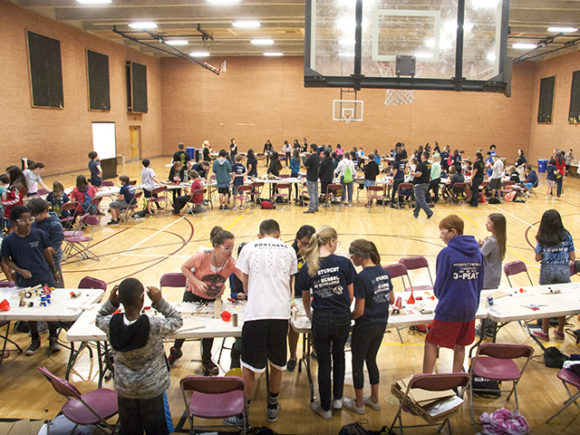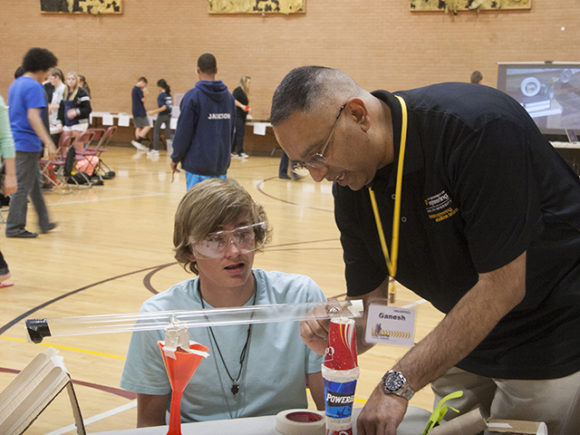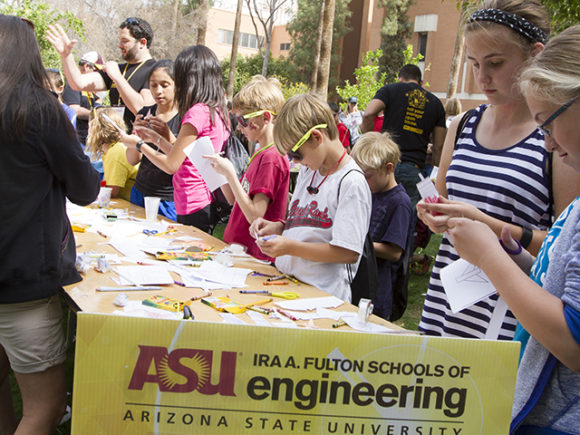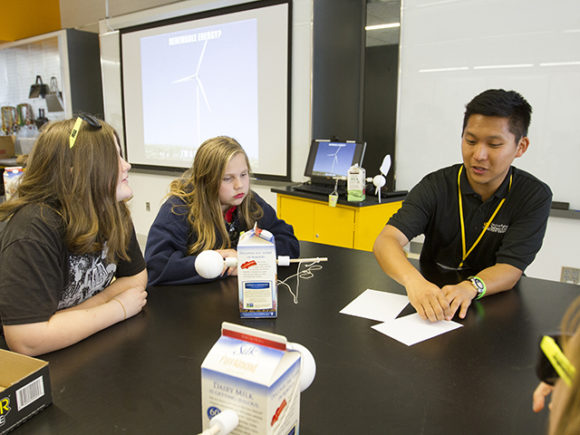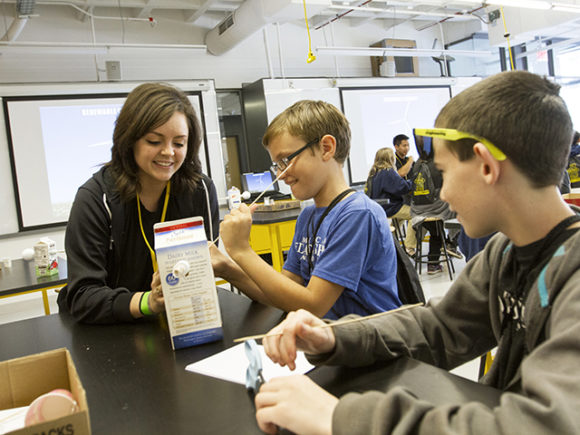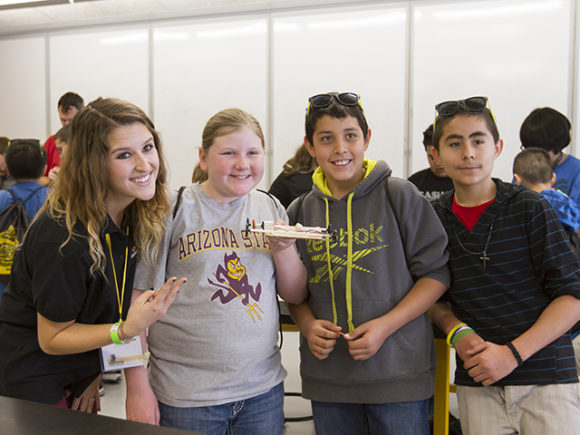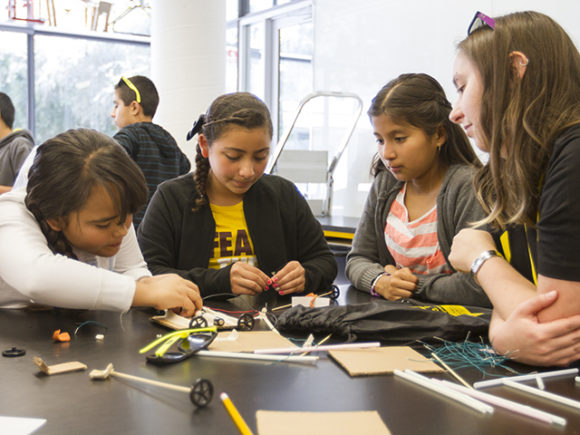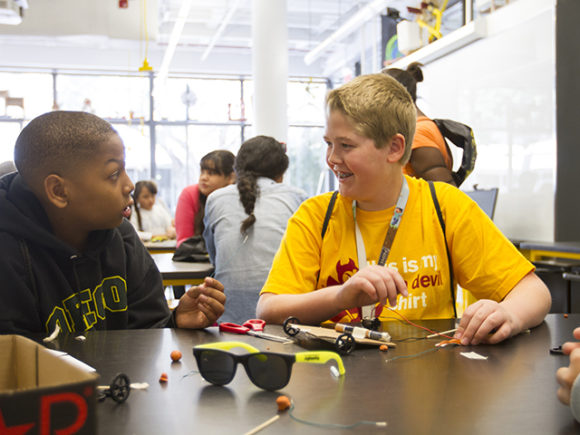
ASU engineering, education students join forces to engage youngsters
For today’s generation of youths growing up in a world increasingly driven by technology, “it is as vitally important for them to learn about engineering practices as it is to know basic scientific concepts,” says Tirupalavanam Ganesh, assistant dean of engineering education in the Ira A. Fulton Schools of Engineering at Arizona State University.
For that to happen, he says, engineers and elementary and middle school teachers must combine their particular skills and knowledge sets. Ganesh has begun working with educators in ASU’s Mary Lou Fulton Teachers College to foster such collaborations.
He prepared more than 30 teacher candidates pursuing education degrees in the Fulton Teachers College to work with engineering students in guiding some of the educational activities at the recent DiscoverE Day presented each year by the Fulton Engineering Schools.
The event brings almost 1,500 elementary and middle school students to ASU’s Tempe campus for a day of interactive engineering exhibits and demonstrations. Many of those students participated in activity sessions led by the teacher candidates.
Inquiry-based learning approach
The students made miniature motorized vehicles, eco-friendly beverage can holders, small windmills and roller-coaster cars.
They constructed contraptions to create chain reactions, designed to help them explore the concept of “cause and effect” as a way to understand relationships in the natural and built worlds. They learned about kinetic sculpture and basic principles of rocketry, and explored the power of light and solar energy.
Each session was designed to introduce upper-level elementary and middle school students – and the ASU teacher candidates – to what Ganesh and others describe as “inquiry-based learning.”
It’s a design-based approach to teaching. “You don’t show kids how to do things, you challenge them to figure things out by themselves and make stuff work,” says teacher candidate Kelly Gilloon, who will complete studies this year for a bachelor’s degree in elementary education with a concentration in science education.
Gilloon supervised sessions in which students constructed holders for six-packs of beverage cans from eco-friendly materials. “You can see how they start to learn engineering lessons when you let them find solutions on their own,” she says, “and you see how they learn to work as a team. They begin to understand how engineering is relevant to everyday things.”
New ideas for teaching
Teacher candidate Mayra Carranza, who is training to teach middle school math, was impressed with students she worked with at DiscoverE Day.
“It was interesting to see all of the different thought processes they used to try solving technical challenges,” Carranza says. “I think with this kind of approach to instruction you can begin to get students to see how math applies to science and engineering.”
Kristin Oney, who is pursuing a master’s degree in secondary education with an emphasis on science education, says the event gave her better ideas for how to design hands-on activities to educate students in STEM (science, technology, engineering and math) through hands-on activities.
“This was an opportunity to actually participate in inquiry-based learning, and that’s valuable experience for us” added Colton Davis, a teacher candidate training to teach eighth-grade science.
Teacher candidates Riley Lazar and Jennifer Fatt say they learned the value of engineers and teachers joining forces for education.
Lazar and Fatt supervised students building small models of motorized cars. They saw the inquiry-based method begin to motivate students to engage in critical thinking.
“We can see the value of teachers and engineers working together on approaches to teaching,” Lazar says. “The students started coming up with all kinds of different ideas to figure out how to make something work,” Lazar says. “Seeing that happen gives us new ideas for how to teach.”
Youngsters get a look at college
JoAnne Skoglund, a teacher at Kyrene Altadeña Middle School in Ahwatukee, and Monica Crowder, a K-8 science specialist for the Kyrene school district, helped bring 110 seventh-graders from the school to DiscoverE Day.
“This is great direct exposure to STEM subjects,” Skoglund says. “We want our students to think like scientists and design like engineers, and experiences like these get them a step closer to that.”
Beyond the educational activities, Crowder says the event helps cement the district’s partnership with ASU that benefits the young students.
“Our students get a look at a college campus, some of them for the first time,” she says. “They get to meet and talk to college engineering students and ask them questions. This makes an impact on them, and starts them thinking that college is something they want in their future.”
Cultivating leadership skills
Kari McCormick came to DiscoverE Day to support her 13-year-old daughter, Hunter, a Kyrene Altadeña student. “She was in an ASU Girls In Engineering summer program and that really sparked something in her,” she says of her daughter. “So I wanted to come to support her interests in [STEM subjects} and support the school for letting students participate in this.”
McCormick, who earned a business degree at ASU and is now a director of a division of a large construction company, says the interactive learning methods demonstrated at a session designed by Ganesh are the key to more than engineering education.
“Any time you can get junior high students together and motivate them to learn cooperation and collaboration to achieve a goal, that’s a great thing,” she says. “That’s what cultivates leadership.”
Plans for future collaborations
“It was evident teacher candidates and engineering students worked together effectively. The activities they facilitated kept both the elementary and middle school students enthralled,” says Jennifer Velez, senior coordinator for the Fulton Engineering Schools’ Student Outreach and Retention Program.
“Their partnership resulted in bringing something extra to DiscoverE Day that made it all the more successful,” says Velez, who helped plan and manage the event.
The collaboration with engineering students and teacher candidates “is only the start of much more to come,” Ganesh says.
He plans to work with more than 80 teacher candidates and their mentors later this year on more ways to integrate lessons on engineering design processes in elementary and middle school curriculum.
In the future, he intends to explore ways to do more than teach only basic engineering design. “I want to eventually advance to methods for incorporating lessons about the systems and modeling aspects of engineering into classroom activities,” he says.
Media Contact:
Joe Kullman, [email protected]
(480) 965-8122
Ira A. Fulton Schools of Engineering































